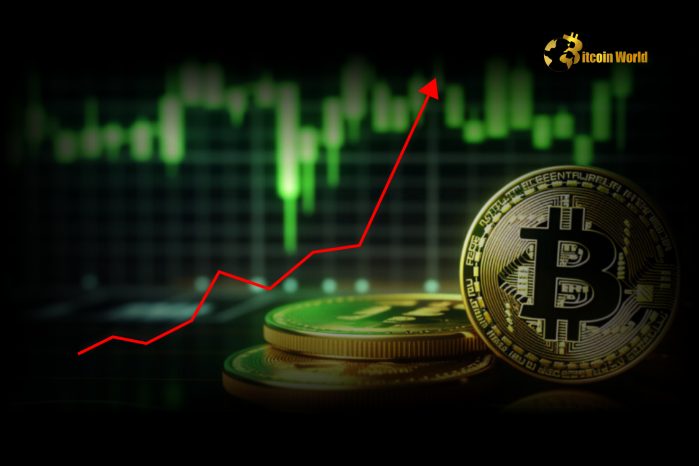Buckle up, crypto enthusiasts! This week promises to be another rollercoaster ride for Bitcoin. As the leading cryptocurrency continues to dance to the tune of global events, understanding the key factors at play is more crucial than ever. Forget guesswork; we’re diving deep into four pivotal trends poised to shape the Bitcoin market this week. Whether you’re a seasoned trader or just dipping your toes into the crypto waters, staying informed is your best weapon in this volatile landscape. Let’s break down what you absolutely need to watch.
Why U.S. Economic Data is a Game Changer for Bitcoin Trends
First on the radar is the release of critical U.S. economic data: the January Consumer Price Index (CPI) and Producer Price Index (PPI). But why should these seemingly traditional economic indicators matter to the decentralized world of Bitcoin? The answer lies in their profound influence on inflation expectations and the Federal Reserve’s monetary policy.
Understanding CPI and PPI:
- Consumer Price Index (CPI): Think of CPI as a measure of the average change in prices consumers pay for a basket of goods and services. It’s a key gauge of inflation from the consumer’s perspective. A higher-than-expected CPI reading often signals rising inflation.
- Producer Price Index (PPI): PPI measures the average change in selling prices received by domestic producers for their output. It can be seen as a leading indicator of CPI, as producer price increases often get passed on to consumers.
How do these impact Bitcoin?
In recent times, Bitcoin has increasingly been viewed as a hedge against inflation. Here’s the connection:
- Inflation Concerns: If CPI and PPI figures are higher than anticipated, it fuels concerns about persistent inflation. This can weaken the U.S. dollar and make assets like Bitcoin, with its limited supply, more attractive as an alternative store of value.
- Fed’s Response: Strong inflation data could push the Federal Reserve to maintain or even increase interest rates to combat rising prices. Higher interest rates can impact risk assets like Bitcoin. However, paradoxically, if inflation is perceived as out of control, Bitcoin’s appeal as a hedge might strengthen, even amidst interest rate hikes.
- Market Sentiment: The release of these figures often triggers significant market volatility. Traders closely watch these numbers to anticipate the Fed’s next move and adjust their positions accordingly. Expect potential price swings in the Bitcoin market around the release times.
Actionable Insight: Keep an eye on economic calendars for the exact release dates and times of the U.S. CPI and PPI. Be prepared for potential volatility in Bitcoin price and consider adjusting your trading strategy based on market reactions to these data releases. Monitoring analyst expectations versus actual figures is also crucial for anticipating market movements.
The Tariff War Escalates: Will Bitcoin Benefit?
The specter of a U.S. tariff war entering its second round adds another layer of complexity to the global economic outlook and, consequently, to the crypto market analysis. Trade tensions can have far-reaching consequences, and Bitcoin, in its unique position, could experience both headwinds and tailwinds.
Understanding the Tariff War Context:
Trade disputes, especially between major economies, can disrupt global supply chains, increase uncertainty, and impact investor sentiment. Escalating tariffs can lead to:
- Economic Slowdown: Higher tariffs can increase costs for businesses and consumers, potentially slowing down economic growth.
- Currency Fluctuations: Trade imbalances and retaliatory tariffs can lead to fluctuations in currency exchange rates.
- Increased Uncertainty: Trade wars create an environment of uncertainty, prompting investors to seek safe-haven assets.
Bitcoin as a Potential Safe Haven?
In times of economic turmoil and geopolitical instability, Bitcoin is often touted as a ‘digital gold’ or a safe-haven asset. Here’s why this tariff war scenario could be relevant for Bitcoin:
- Flight to Safety: If traditional markets react negatively to escalating trade tensions, some investors might seek refuge in alternative assets like Bitcoin, perceiving it as uncorrelated to traditional markets and immune to government policies affecting fiat currencies.
- Devaluation Concerns: Tariff wars can sometimes lead to currency devaluation as countries attempt to make their exports more competitive. In such scenarios, Bitcoin, with its decentralized nature and limited supply, could become more attractive as a store of value compared to potentially weakening fiat currencies.
- Increased Volatility: However, it’s important to note that increased global economic uncertainty can also lead to heightened volatility across all markets, including the crypto market analysis. Bitcoin is not immune to broader market sentiment shifts.
Challenge: While Bitcoin could benefit from safe-haven flows, the overall risk-off sentiment in markets during a trade war could also lead to investors reducing exposure to all risk assets, including cryptocurrencies. The impact is not always straightforward and depends on the specific dynamics of the trade dispute and market reaction.
Actionable Insight: Monitor news related to the tariff war closely. Analyze how traditional markets are reacting. If you observe a significant downturn in equities and traditional safe havens like gold also showing limited upside, Bitcoin might present an interesting, albeit volatile, alternative. However, always manage risk carefully in uncertain times.
Thinning Order Books: Decoding Market Depth and Volatility
The third trend to watch is the thinning order book and its impact on market depth. This might sound technical, but it’s crucial for understanding potential volatility and how easily Bitcoin price can move.
What is Market Depth?
Market depth refers to the market’s ability to absorb large buy or sell orders without causing significant price movements. It’s reflected in the order book, which lists buy (bid) and sell (ask) orders at different price levels. A deep order book has substantial orders on both sides, indicating strong liquidity and resilience to large trades.
Thinning Order Book – What does it mean?
A thinning order book means there are fewer buy and sell orders at various price levels. This can happen due to various factors, including reduced trading activity, market uncertainty, or changes in market maker behavior. A thin order book has several implications:
- Increased Volatility: With fewer orders to absorb buying or selling pressure, even relatively small trades can cause significant price swings. This leads to higher volatility in Bitcoin price.
- Wider Bid-Ask Spreads: In a thin market, the difference between the highest bid price and the lowest ask price (the bid-ask spread) can widen. This increases trading costs, especially for larger trades.
- Flash Crashes and Pumps: Thin order books make the market more susceptible to flash crashes (sudden sharp price drops) and pumps (sudden sharp price increases) as there’s less resistance to large market orders.
Example: Imagine an order book with only a few Bitcoin offered for sale at $45,000. A large market buy order could quickly exhaust these sell orders, pushing the price significantly higher until it finds the next substantial sell order. Conversely, a large sell order in a thin buy-side order book can trigger a rapid price decline.
Actionable Insight: Be extra cautious when trading in periods of thinning order books. Reduce your position sizes, use limit orders instead of market orders to control your entry and exit prices, and be prepared for potentially rapid and unpredictable price movements. Monitor order book depth on exchanges you use to gauge market liquidity.
Retail Investors Continue BTC Accumulation: A Bullish Signal?
Finally, the continued BTC accumulation by retail investors since December 2023 is a noteworthy trend. While institutional interest often grabs headlines, the steady accumulation by smaller investors can be a powerful underlying force in the Bitcoin market.
Understanding Retail Accumulation:
Retail investors, often referred to as ‘the crowd,’ are non-professional traders who invest smaller amounts compared to institutions or whales. Data indicating continued BTC accumulation by this group suggests:
- Long-Term Conviction: Retail accumulation, especially over a sustained period, often signals strong long-term belief in Bitcoin’s potential. It suggests that a significant segment of the market is buying and holding, rather than just trading for short-term gains.
- Supply Squeeze Potential: If retail investors are consistently accumulating and moving Bitcoin off exchanges into personal wallets (for long-term holding), it can gradually reduce the available supply on exchanges. This supply squeeze can, over time, exert upward pressure on Bitcoin price, especially when demand increases.
- Decentralized Growth: Broad-based retail accumulation reinforces Bitcoin’s decentralized nature and reduces reliance on large institutional players. A healthy mix of retail and institutional participation is often seen as a positive sign for the long-term sustainability of the market.
Is it a Bullish Signal?
While retail accumulation is generally considered a positive indicator, it’s not a guaranteed predictor of price increases. Market sentiment can shift, and broader economic factors still play a significant role. However, sustained retail accumulation provides a solid foundation of demand and indicates a healthy level of grassroots interest in Bitcoin.
Actionable Insight: Track on-chain data related to exchange balances and wallet activity to monitor retail accumulation trends. While not a sole indicator, it can provide valuable context when combined with other market analysis. Consider it as a signal of underlying market strength and long-term investor confidence in Bitcoin.
Conclusion: Staying Ahead in the Bitcoin Game
This week in the Bitcoin market is shaping up to be influenced by a potent mix of macroeconomic factors, geopolitical events, and internal market dynamics. From navigating the implications of CPI and PPI data to understanding the potential impacts of a tariff war, deciphering order book depth, and recognizing the steady hand of retail accumulation, staying informed and adaptable is key. Remember, the crypto market thrives on information and reacts swiftly to global cues. By keeping a close watch on these four trends, you’ll be better equipped to navigate the week’s volatility and make informed decisions in the ever-evolving world of Bitcoin.
To learn more about the latest crypto market trends, explore our article on key developments shaping Bitcoin price action.
News – BitcoinWorld – Read More








